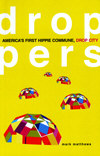Droppers
"But we have sensible reasons for not breaking out into the huge freedom of irregular shapes – once done we would no longer have the aid of our machines, tools and simple formulae." Steve Baer, a fellow-traveler of "the droppers," wrote these words in 1968 to describe the unorthodox architecture at Drop City, but the same quote can be applied in hindsight to the social experiments occurring there. Droppers provides a comparative look at Drop City and other communal ventures in America's past. Mark Matthews asserts that Drop City failed because it did not attempt to learn any lessons from past communes. The droppers intentionally charted out a new society without utilizing the "tools of history"; the commune took on an "irregular shape" that ultimately led to its destruction.
"But we have sensible reasons for not breaking out into the huge freedom of irregular shapes – once done we would no longer have the aid of our machines, tools and simple formulae." Steve Baer, a fellow-traveler of "the droppers," wrote these words in 1968 to describe the unorthodox architecture at Drop City, but the same quote can be applied in hindsight to the social experiments occurring there. Droppers provides a comparative look at Drop City and other communal ventures in America's past. Mark Matthews asserts that Drop City failed because it did not attempt to learn any lessons from past communes. The droppers intentionally charted out a new society without utilizing the "tools of history"; the commune took on an "irregular shape" that ultimately led to its destruction.
Matthews's book is both a history of communalism and a biography of Eugene Victor Debs Bernofsky, the founder of the first hippie commune of the 1960s. His story is part of a growing historical literature linking the "old Left" of the 1930s with the "new Left" movements of the 1960s. Like many of the new Left, Eugene and his brother, Karl Marx Bernofsky, grew up in New York City as "red diaper" babies. Their parents were Jewish immigrants who raised their sons on communist literature and a non-conformist outlook. In his youth, Eugene dreamed of being a writer and escaping the city; he randomly disappeared for days on his bicycle with only a pocket full of change and his typewriter.
Eventually Eugene's adventurous spirit led him to the non-adventurous destination of Kansas University (KU). At KU Bernofsky met a young artist by the name of Richert who was obsessed with pacifism and the abstractionism of Rothko. This Jewish and Mennonite duo challenged the mundane conformity of Kansas life, smoking grass and pulling off eccentric stunts; their favorite artistic act was "dropping" random objects out their loft window tied to a rope to observe people's reactions. These exploits gained them the nickname of "droppers."
In the winter of 1964, Eugene settled on a small farm with his wife. Instead of raising children as was expected, they grew marijuana. After harvest time, the couple relocated to the lower-east side of Manhattan to find a market for their crop. Eugene was assisted in his "capitalist venture" by his poetic neighbor, Allen Ginsberg. Ginsberg helped to fill the coffers of Bernofsky's finances and imagination. Following his "faith in the cosmic forces," Eugene took his $10,000 of drug money and set out to build a new civilization, intentionally rejecting any lessons from his elders or the past; the future was now and needed to be charted in a new and youthful fashion. Hence, on a pocket-full of hash cash and illogical idealism, Drop City was born.
In May, 1965, Eugene and his wife bought a five-acre desert plot in southern Colorado. Bernofksy and Richert set about building geometric domes constructed completely with found materials including bottle caps, car rooftops, chicken wire, railroad ties, and used nails. Starting as just two couples, the dropper community grew to over thirty artists and restless souls. The commune centered on naïve notions of freedom and self-reliance. Order was not enforced through rules, but by a leadership of "quiet example."
New participants took advantage of the non-hierarchical structure of Drop City to promote their own agenda. In 1966, a young writer nicknamed "Peter Rabbit" joined the commune. Rabbit was a dominating figure who wanted to "market" Drop City on an international level. Initial droppers were happy existing in obscurity as a "gentle nurturing home where creative people could make art for life's sake"; Peter felt otherwise. Without members having any rules in place to stop him, Rabbit dominated the commune's newspaper to promote his own vision of Drop City. In a tragic tale reminiscent of Lenin and Stalin, Eugene sat by paralyzed as Peter essentially hijacked Drop City.
Peter's efforts culminated in the "Joy Festival" during the summer of 1967. The festival attracted random burnouts and hippies from around the world. This week of festivities destroyed two years of hard work; Drop City was transformed from a mutual-aid community into a transient camp of bongs, booze, bums, and overflowing latrines. Eugene and his wife left immediately. Although Drop City grew in its numbers, without Bernofsky its spiritual grounding was missing and it died within a few years.
Drop City's mythology laid the foundation for over three thousand other communal projects over the next decade. Despite this, Bernofsky ends his story cynically, describing communal living as "a batch of bullshit" (a sentiment the reviewer can relate with after a disastrous PBR summer on a punk commune). Almost metaphorically, Eugene argues that if he and Richert had simply built "regular shacks" instead of domes, that Drop City may have survived; sometimes societies have "regular shapes" and "simple formulas" because the past proves that they work.
Matthews's book is an engaging and refreshing reminder that America has been no stranger to cultural and social experimentation. Matthews's own experimentation in chapter structures was also refreshing. To contextualize each section, Matthews opens with 10-12 random Time Magazine excerpts from the period as well as older stories on America's past. His quotes capture the restless spirit of conflict and alienation that inspired young people to seek out social alternatives through communal experiments. He compares dropper participants to communal leaders of the past, highlighting similar character flaws as well as idealistic outlooks. Overall, Droppers was a well written and passionate examination of an often misunderstood phenomenon in American history that should be a fascinating read for young people or nostalgic baby boomers.





